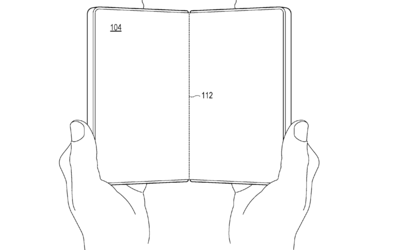Microsoft is reportedly exploring a return to the smartphone market with a new foldable device, despite the discontinuation of its Surface Duo line. A recently uncovered patent application suggests the company is working on a novel hinge mechanism designed to rival existing foldable phones from Samsung and others.

The patent, filed with the United States Patent and Trademark Office on February 29, details a "spine cover plate" system intended to protect the phone's single hinge. This design aims to address key challenges with current foldable devices, namely hinge durability and the visibility of the crease on the flexible display.
The patent application indicates that the device would adopt a book-style design, similar to Samsung's Galaxy Z Fold series, featuring a flexible display that folds inward. The primary focus of the patent is the spine cover plate, which is designed to shield the hinge mechanism from damage.
A key difference between Microsoft's concept and existing foldable designs lies in the automatic adjustment of the spine cover. This adjustment would occur during the opening and closing of the phone, minimizing gaps around the hinge. This is intended to offer superior protection against dust and water ingress. Currently, Samsung's foldables offer an IPX8 rating, providing water resistance but not complete waterproofing.
Microsoft's patent also suggests the new hinge mechanism could significantly reduce, or even eliminate, the visible crease that is characteristic of foldable displays. Furthermore, the design aims to minimize the overall thickness of the device when folded.
According to the patent, retracting the spine cover plate towards the central spine as the device folds allows for a reduced width. This, in turn, could improve the device's ergonomics and make it easier to handle with one hand.
While the concept is intriguing, the practicality of adding another movable component to an already complex foldable mechanism remains uncertain. The smartphone industry is actively seeking solutions to eliminate the crease on foldable displays, and some manufacturers have implemented water-drop folding mechanisms to mitigate the issue. However, a completely crease-free foldable device has yet to be achieved.
The durability of foldable phones, given their numerous moving parts, is also a significant concern. Whether Microsoft's spine cover plate design can enhance durability while achieving a slimmer profile and a less visible crease remains to be seen.
Newer articles
Older articles
 Rishabh Pant's Fearless Batting Revolutionizes Test Cricket: Greg Chappell Draws Adam Gilchrist Comparison
Rishabh Pant's Fearless Batting Revolutionizes Test Cricket: Greg Chappell Draws Adam Gilchrist Comparison
 Chess Sensation: 9-Year-Old Indian Prodigy Holds Magnus Carlsen to Draw in Online Tournament
Chess Sensation: 9-Year-Old Indian Prodigy Holds Magnus Carlsen to Draw in Online Tournament
 Nitish Rana Set for Delhi Return After Disappointing Uttar Pradesh Stint
Nitish Rana Set for Delhi Return After Disappointing Uttar Pradesh Stint
 India Launches Official Bid for 2036 Summer Olympics, Eyes Ahmedabad as Host City
India Launches Official Bid for 2036 Summer Olympics, Eyes Ahmedabad as Host City
 Hetmyer's Unbeaten Blitz Secures Third Straight Win for Seattle Orcas in MLC 2025
Hetmyer's Unbeaten Blitz Secures Third Straight Win for Seattle Orcas in MLC 2025
 Pant Climbs to Career-Best in ICC Test Rankings; Bumrah Retains Top Bowling Spot, Root Still Leads Batters
Pant Climbs to Career-Best in ICC Test Rankings; Bumrah Retains Top Bowling Spot, Root Still Leads Batters
 Jaiswal Aims to Shatter Dravid's 26-Year-Old Test Record in England
Jaiswal Aims to Shatter Dravid's 26-Year-Old Test Record in England
 De Villiers Questions India's Strategy on Bumrah's Playing Time Amidst England Test Series
De Villiers Questions India's Strategy on Bumrah's Playing Time Amidst England Test Series
 Rishabh Pant's Composed Response Deflates Harry Brook's Sledging Attempt in Edgbaston Test
Rishabh Pant's Composed Response Deflates Harry Brook's Sledging Attempt in Edgbaston Test
 Vaibhav Suryavanshi Smashes Record-Breaking Nine Sixes, Propels India U-19 to Victory Over England U-19
Vaibhav Suryavanshi Smashes Record-Breaking Nine Sixes, Propels India U-19 to Victory Over England U-19